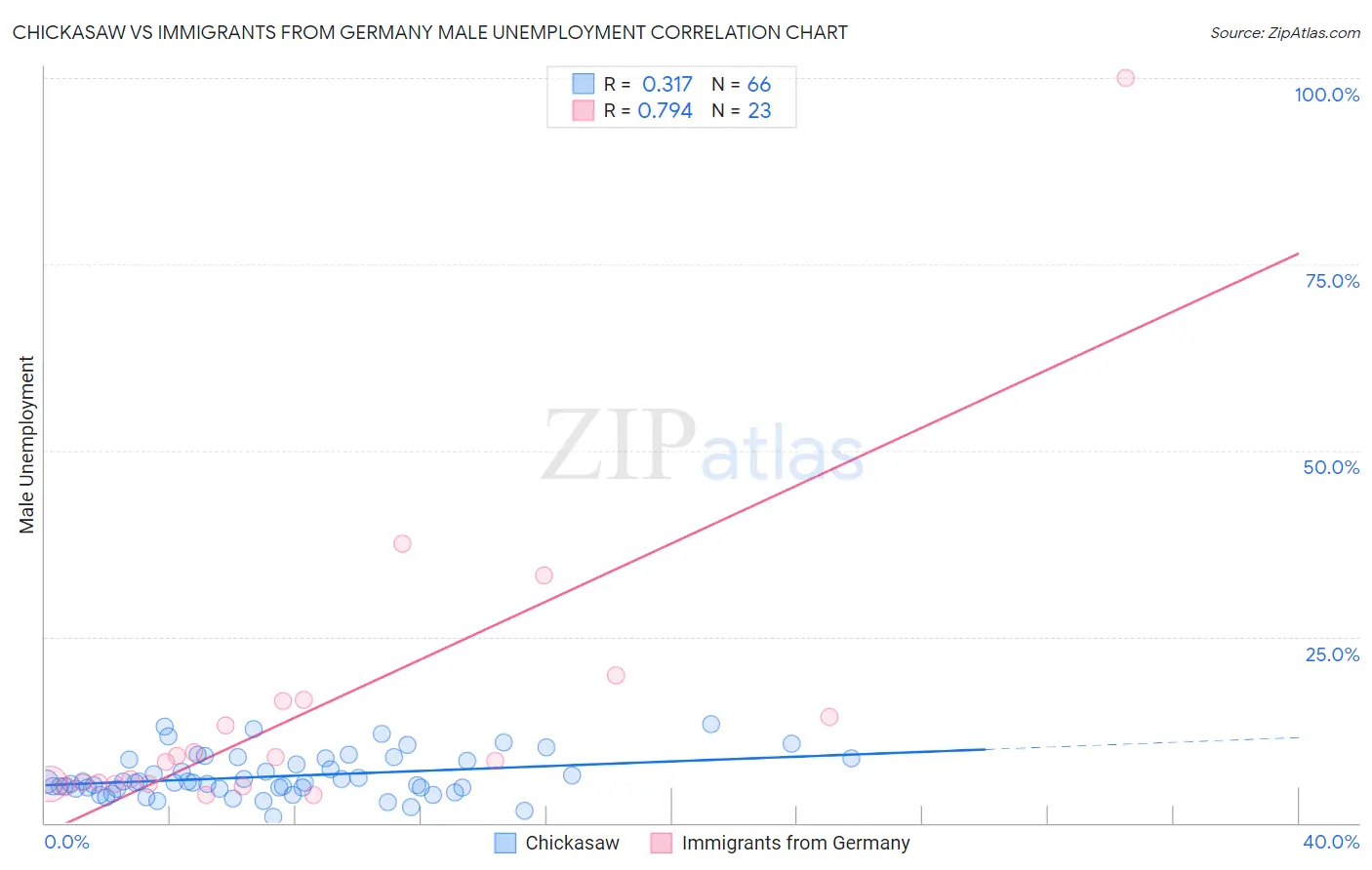Chickasaw vs Immigrants from Germany Male Unemployment
COMPARE
Chickasaw
Immigrants from Germany
Male Unemployment
Male Unemployment Comparison
Chickasaw
Immigrants from Germany
5.2%
MALE UNEMPLOYMENT
82.9/ 100
METRIC RATING
132nd/ 347
METRIC RANK
5.2%
MALE UNEMPLOYMENT
83.0/ 100
METRIC RATING
131st/ 347
METRIC RANK
Chickasaw vs Immigrants from Germany Male Unemployment Correlation Chart
The statistical analysis conducted on geographies consisting of 147,341,260 people shows a mild positive correlation between the proportion of Chickasaw and unemployment rate among males in the United States with a correlation coefficient (R) of 0.317 and weighted average of 5.2%. Similarly, the statistical analysis conducted on geographies consisting of 460,829,460 people shows a strong positive correlation between the proportion of Immigrants from Germany and unemployment rate among males in the United States with a correlation coefficient (R) of 0.794 and weighted average of 5.2%, a difference of 0.020%.

Male Unemployment Correlation Summary
| Measurement | Chickasaw | Immigrants from Germany |
| Minimum | 0.90% | 3.8% |
| Maximum | 13.2% | 100.0% |
| Range | 12.3% | 96.2% |
| Mean | 6.3% | 15.0% |
| Median | 5.4% | 8.3% |
| Interquartile 25% (IQ1) | 4.7% | 5.2% |
| Interquartile 75% (IQ3) | 8.5% | 16.4% |
| Interquartile Range (IQR) | 3.8% | 11.2% |
| Standard Deviation (Sample) | 2.8% | 20.6% |
| Standard Deviation (Population) | 2.8% | 20.1% |
Demographics Similar to Chickasaw and Immigrants from Germany by Male Unemployment
In terms of male unemployment, the demographic groups most similar to Chickasaw are Immigrants from Malaysia (5.2%, a difference of 0.070%), Colombian (5.2%, a difference of 0.18%), Immigrants from Western Europe (5.2%, a difference of 0.21%), Pakistani (5.2%, a difference of 0.24%), and Hungarian (5.2%, a difference of 0.25%). Similarly, the demographic groups most similar to Immigrants from Germany are Immigrants from Malaysia (5.2%, a difference of 0.050%), Immigrants from Western Europe (5.2%, a difference of 0.20%), Colombian (5.2%, a difference of 0.20%), Hungarian (5.2%, a difference of 0.23%), and Pakistani (5.2%, a difference of 0.26%).
| Demographics | Rating | Rank | Male Unemployment |
| Mongolians | 88.4 /100 | #121 | Excellent 5.1% |
| Nicaraguans | 88.2 /100 | #122 | Excellent 5.1% |
| Palestinians | 87.7 /100 | #123 | Excellent 5.1% |
| Immigrants | Latvia | 87.5 /100 | #124 | Excellent 5.1% |
| Immigrants | Lithuania | 87.2 /100 | #125 | Excellent 5.1% |
| Immigrants | Colombia | 86.8 /100 | #126 | Excellent 5.1% |
| Immigrants | Brazil | 86.3 /100 | #127 | Excellent 5.2% |
| Hungarians | 85.1 /100 | #128 | Excellent 5.2% |
| Immigrants | Western Europe | 84.8 /100 | #129 | Excellent 5.2% |
| Immigrants | Malaysia | 83.5 /100 | #130 | Excellent 5.2% |
| Immigrants | Germany | 83.0 /100 | #131 | Excellent 5.2% |
| Chickasaw | 82.9 /100 | #132 | Excellent 5.2% |
| Colombians | 81.1 /100 | #133 | Excellent 5.2% |
| Pakistanis | 80.5 /100 | #134 | Excellent 5.2% |
| Immigrants | Saudi Arabia | 80.1 /100 | #135 | Excellent 5.2% |
| Lebanese | 79.9 /100 | #136 | Good 5.2% |
| Immigrants | Eastern Africa | 79.8 /100 | #137 | Good 5.2% |
| Immigrants | Croatia | 79.7 /100 | #138 | Good 5.2% |
| Kenyans | 79.4 /100 | #139 | Good 5.2% |
| Brazilians | 79.3 /100 | #140 | Good 5.2% |
| Immigrants | Switzerland | 79.2 /100 | #141 | Good 5.2% |